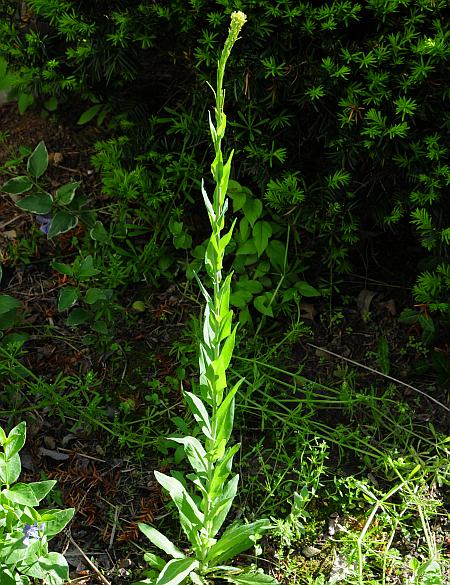Turritis glabra L.
Tower Mustard

Native
CC = 8
CW = 5
MOC = 2
SRank = S1
© SRTurner
Turritis glabra L.Tower Mustard | |
 |
Native CC = 8 CW = 5 MOC = 2 SRank = S1 |
© SRTurner |
|
Family - Brassicaceae Habit - Biennial or rarely short-lived perennial forb.
Stem - Erect, to 1.2 m, often few-branched in the upper or lower half, usually pubescent with mostly unbranched and fewer forked, stalked hairs near the base, glabrous and glaucous in the upper half.
Leaves - Basal and alternate. Basal leaves 6-12 cm long, oblong to broadly oblanceolate or spatulate in outline, entire to toothed or irregularly pinnately divided, narrowed at the base to a short petiole, usually coarsely pubescent with stalked, 2-branched hairs. Stem leaves appressed to spreading, sometimes overlapping, 3-15 cm long, lanceolate to ovate in outline, sessile, clasping the stem, usually with pointed auricles, entire or toothed, glabrous or the lowest ones sometimes sparsely hairy, often glaucous.
Inflorescence - Narrow terminal racemes or panicles, the flowers without bracts.
Flowers - Sepals 3-5 mm long, oblong-elliptic, glabrous, often purple-tinged. Petals 5.0-8.5 mm long, cream-colored to pale yellow, rarely tinged with purple.
Fruits - Siliques 5-10 cm long, erect at maturity, appressed to the inflorescence axis, straight or nearly so, nearly circular or slightly 4-angled in cross-section, dehiscing longitudinally by the valves breaking off without coiling, each valve with a midnerve extending the full length or nearly so. Seeds usually in 2 rows in each locule, 0.6-0.9(-1.2) mm long, irregularly angular-elliptic in outline, somewhat flattened, usually irregularly winged at both ends, the surface with a netlike or honeycomb-like pattern of ridges and pits, orange.
Flowering - May - June. Habitat - Bottomland forests, railroads, sandy disturbed areas. Origin - Native to the U.S. Lookalikes - Arabis hirsuta. Other info. - This species is rare in Missouri, collected so far from only two counties. It is more common to our north, including Canada, and also the western half of the U.S. In appearance the plant is similar to the somewhat more common Arabis hirsuta, but can be distinguished by being both glabrous and glaucous in the upper half, as well as having fruits which are round (not flattened) in cross section. Photographs taken near Labadie, Franklin County, MO, 5-2-2020; and at Illiniwek Village State Historic Site, Clark County, MO, 5-16-2024 (SRTurner). |